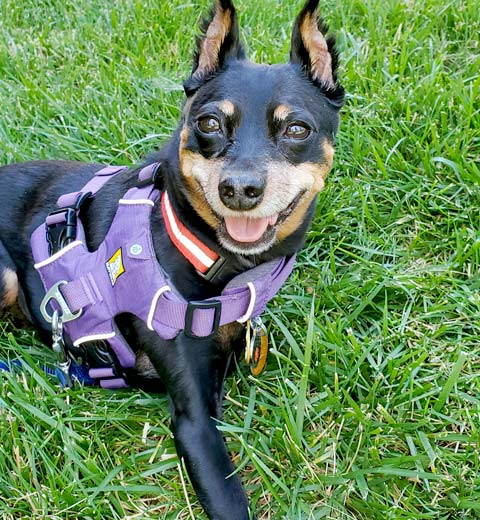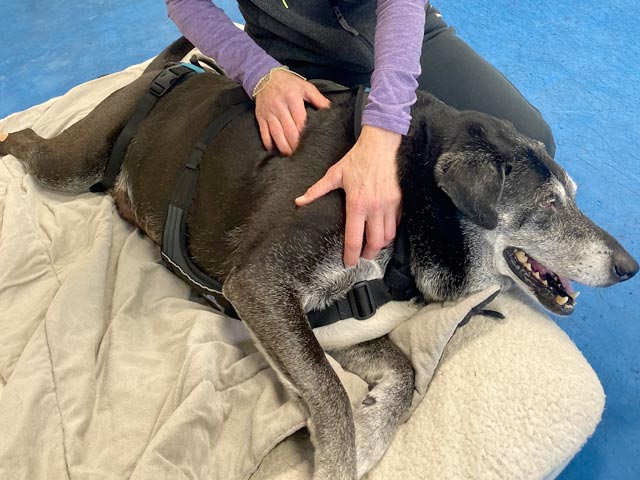Osteoarthritis problems in three-legged dogs are one of the biggest challenges Tripawd parents will face. But the good news is that we can do lots to minimize the impact. Today you’ll learn how, from the world’s leading veterinary orthopedics expert Dr. Denis Marcelin-Little, DEDV, DACVS, DACVSMR, professor of Surgical and Radiological Sciences at the University of California at Davis.
This video chat with Dr. Marcellin-Little includes the second to last episode of our interviews with faculty members at UC Davis School of Veterinary Medicine from October 2019. This is just a snippet: catch all unabridged interviews on Tripawd Talk Radio.
How to Prevent and Treat Osteoarthritis Problems in Three Legged Dogs

Watch below to learn from Dr. Denis Marcellin-Little. Today he shares his thoughts about preventing and treating orthopedic problems in three-legged dogs. Here’s what you will learn:
- Keep your Tripawd lean. Below-average weight on an animal is critical, and proven to slow down osteoarthritis effects. Weight is the one factor you have total control over, even more than exercise!
- Stay alert for orthopedic problems. Front leg Tripawds are more prone to elbow and shoulder osteoarthritis. Rear leg Tripawds are more at risk of cranial cruciate injury. Early diagnosis and aggressive treatment leads to better outcomes.
- Be aggressive with pain management. Use proven pain relief modalities like non-steroidal anti-inflammatory drugs (NSAIDs) to keep your pet moving and active. Once a pet stops enjoying physical activity, weight gain and osteoarthritis immediately follows and decreases quality of life.
Watch and Learn About Osteoarthritis in Three Legged Dogs
Listen below to the entire interview with Dr. Marcellin-Little on Tripawd Talk Radio or keep reading for the full transcript of our interviews.
Watch this space for Part II of our interview with Dr. Marcellin-Little,
“Considerations for Remaining Leg Surgery in Three Legged Dogs”

Transcript: About Osteoarthritis Problems
in Three Legged Dogs
with Dr. Denis Marcellin-Little
MARCELLIN-LITTLE: Good afternoon. My name is Denis Marcellin-Little. I am an orthopedic surgeon for small animal and I am now part of UC Davis faculty. I am very focused on orthopedic diseases and disability, managing disability, promoting locomotion, protecting locomotion or recovering locomotion.
TRIPAWDS: Let’s say you have a young three-legged dog in front of you and it has no arthritis right now. The dog is healthy and looks like he’s going to have a great life. What would you say to the owner about preventing osteoarthritis?
MARCELLIN-LITTLE: That’s a good question about osteoarthritis because it’s so common in dogs. We generally float a number of one dog in five having osteoarthritis and we don’t even know these numbers are super real but it’s basically super common. If your dog is an amputee, it’s still going to be at a high risk of osteoarthritis.
Be Extra Alert for Osteoarthritis in Tripawds
Of course, amputees that are missing a back leg move a lot better and more easily than amputees who are missing a front leg. If I have a dog with a single front leg, I’m really worried about its elbow because that’s the more common maybe osteoarthritis we’ve seen, fairly commonly in both the elbow and the shoulder.
In the shoulder, it’s more discreet. It’s better tolerated. You think about the shoulder, it’s used in dogs, kind of in the middle of its reach so they don’t really have to go fully extended or fully flexed. When they have osteoarthritis, they usually don’t stretch their joint to the extreme which tends to be the more painful thing.
It’s also a very loose joint, the shoulder relative to the elbow. And loose joints tolerate osteoarthritis better. The real risk is elbow osteoarthritis. And elbow osteoarthritis is very common in big dogs. Maybe one dog in six or so has it according to OFA statistics.
With elbow osteoarthritis, you are going to be using that joint very close to its full extension. That’s going to be hurting. A lot of elbow osteoarthritis comes from elbow dysplasia and it’s a bit of a genetic thing. You could look at the statistics first and see if my dog is in the list of dogs that commonly have elbow osteoarthritis. So start at the OFA.org and look at elbow statistics. It’s available.
Keep your Tripawd lean.
We also want to do everything we can to slow down or minimize the expression and the progression of osteoarthritis. We are getting back to our discussion about being lean. Being light weight will greatly slow down the progression of osteoarthritis. We know that for a fact or from life-long studies. And so elbow osteoarthritis must be slowed down by being light weight. It’s critically important.
Exercising regularly will keep you strong when you get to do it with caution (and that’s not easy). Weight is really the one thing that you can predict and control the most.
Be proactive with pain management.

Medications tend not to really influence the course of the disease that much. Some medication promotes like corticosteroids which should be avoided because they are fairly detrimental to arthritic joints.
The non-steroidal anti-inflammatory drugs (NSAIDs) are fairly neutral except they alleviate pain. If your dog is in pain, they are really going to benefit from NSAIDs because they can stay more mobile, they can stay fitter if they don’t self-limit or restrict their activity because of chronic pain. We really want to tackle pain more aggressively and more thoroughly by using truly effective methods rather than hypothetical methods. We want to focus on the clearly known like NSAIDs to alleviate pain so we don’t go from acute pain to chronic pain and then lost of fitness. We want to avoid that.
More about rear leg Tripawd dogs …
From the back legs, we are in a better situation because dogs walk better when they’re missing a back leg than a front leg. The joints we are going to be particularly worried about are going to be the knee and the hip. We also want to know what breed is going to be at risk of cruciate injury. There are good papers. The best one is from a gentleman named Witsberger in JAVMA that talks about the risk of getting cruciate injury*.
The same paper also looked at the risk of getting hip dysplasia based on different breeds. That’s something that’s important to discuss. Pay attention to avoid particularly strenuous exercise if you are at risk of a cruciate injury. And also, keep an eye on the hip joint, making sure that you don’t develop a lot of hip pain from hip dysplasia.
*”Prevalence of and risk factors for hip dysplasia and cranial cruciate ligament deficiency in dogs.” Witsberger TH1, Villamil JA, Schultz LG, Hahn AW, Cook JL.
Treat problems as soon as possible!
Just like for the front leg, we are particularly interested in slowing the progression of any problem that’s already there, such as osteoarthritis in the knee or in the hip. And so, we are going to have to keep dogs lean. We are going to have to exercise regularly to keep them strong. Staying on top of it, if we think our dog has a problem, we should seek advice and get objective information as early as possible because problems treated early are going to be – maybe they are being managed the same way but the recovery will be a lot safer.
You can imagine, you had a TPLO and you only have one back leg, the fitter you are and the healthier you are, the faster you will get that episode behind you. If we wait until you can barely walk then your recovery will become both very dangerous and very challenging. So we want to avoid that. So we treat things rapidly, diagnose them. If we are unsure, we seek the help of somebody who can help us be sure. Manage things promptly and effectively.
(end of first video transcript,
Osteoarthritis Problems in Three Legged Dogs)
I have an 11 year old tri-paw. It is her back leg that was amputated at 7mth. She had an accident at 2 that now her only back knee cap is fused on the out side. 6 days ago the back leg stopped working. She is in no pain and her normal self. We have a sling to walk her around and to use the bathroom. We brought her to vet and she had a very bad ear infection and got medication. The infection is on the same side as her leg. The ear is now clearing up. Like I said she is still a happy girl. What else can I do to get that leg working again. She can’t put weight on it. So drags butt around the house. No winning or whimpering and looks happy but I want to do more so she can be more independent. Help!
For best results consult with a certified canine rehab therapist for proper evaluation, treatment recommendations and an exercise program designed to specifically address your dog’s needs. Visit a CCRT or CCRP and the Tripawds Foundation can pay for your first visit! Learn more at https://tri.pet/findrehab
Is there a prosthetic that can help three-legged dogs with amputated front leg? Where can I order or get one for my dog?
Glynda, there are no true prosthetics with articulating joints for a front-leg amputee with no residual limb. Some companies are making brace-type supports that are called prosthetics, but a true prosthetic is an ideal solution and so far unfortunately there isn’t one out there yet. Hopefully soon! Meanwhile please take advantage of the Tripawds Foundation’s Rehab Reimbursement Program to see how your pup can be helped in other ways. He may not need that level of support yet, so let a professional help you there and us too! Please don’t buy any kind of device until you let them evaluate your dog. A poorly fitting device can be worse than no device at all.
Hi. I have a tripod that is missing his front left leg and began to show symptoms of discomfort walking about 7 months ago. I’ve been giving him Dasuquin with MSM for 10 years (since I adopted him) and about 6 months ago gave him Adequan (injections twice a week for 4 weeks). He seemed to respond very well to the Adequan and we didn’t do additional injections after that. Now that he is beginning to show pain again should I put him on Adequan on a permanent basis? In your opinion does Adequan work? It’s quite expensive so I want to make sure it’s effective.
For best results, please consult with a certified canine rehab therapist for proper evaluation, treatment recommendations and an exercise program designed to specifically address your dog’s needs. Visit a CCRT or CCRP and the Tripawds Foundation can pay for your first visit! https://tri.pet/findrehab
Hi there, while my dog isn’t a tripod (2.5 yr St Bernard mix), is left front leg was broken from abuse and did not heal correctly. The shelter sent him to an orthopedic vet who opted not to amputate due to his size (85lbs). We’ve done PT (lots of swimming) and he has regained about 90% of function back in that leg (from about 20%). While this is great, I am worried about his other joints/legs, especially as he ages.
Would it be a good idea to start him on a long term joint supplement? If so, do you have recommendations?
Hi Jenn, it’s great your dog is doing so well. You are giving him extra great care! One of the best things you can do is to keep him slimmer than most dogs of his breed type. And we encourage every pet parent of a three or three and a half legged dog to first invest supplements funds into a canine rehabilitation therapist evaluation instead. They can guide you on the best exercises and supplements for his specific physiology. For now, consider krill or fish oil, and these vet-approved supplements may be helpful to try.
Thank you for having this information available. We have a Dutch Shepherd (we adopted her at 2yrs old after being abused at her 2 previous homes so badly that the animal shelter took her back leg). She is now 6yr old, and although she is very active (we keep her lean and walk her 2x a day), we have noticed her limp from time to time or sit on her back remaining leg because she gets tired. Due to our finances, we are unable to go to our vet (that just was purchased by a larger company and tripled their rates).
We live on the corner of a suburban neighborhood where lots of people walk their pets. Our Dutch Shepherd loves to greet these people and runs up and down the fence doing it. She does this sometimes with gusto and pulls her back remaining leg. We give our girl glucosamine/chondroitin/MSM, pre/probiotic, fresh veggies, Hills Science Diet and try everything we can to keep her healthy. What other supplements or OTC medications can we give her occasionally to relieve pain when she’s having a bad day?
Hi Shan, thanks for adopting this sweet girl! She’s so lucky to find her way to you. Please consider joining us in the Discussion Forums so we can help you and your girl more frequently. Meanwhile I know it’s super hard to keep an active breed like a Dutchie mellow enough to avoid these painful episodes. Unfortunately pain management takes a multi-modal approach, usually requiring more than just medications or supplements. For instance, passive range of motion exercises and stretching are helpful to keep her limber, but you also know how to do them correctly so you don’t hurt her. Please consider taking advantage of our free Tripawds Rehab Reimbursement Program, which pays for your first therapy visit up to $200. Your girl can get a free initial evaluation by a therapist, and they can assess her strengths and weaknesses. Even if you only go one time, it’s super educational so you can learn how to help manage her activity level and any pain. It’s a better deal than throwing money at supplements that may or may not work as well as they claim. Let us know if you have any questions.
I have a tripawd dog. American pit bull, he’s lean and very healthy. But recently we have noticed he had a slight arch right behind the neck/spin area. He loves running and going on walks. Is there certain things I can look for more closely to see if something is wrong? Vets say he is very healthy and is always full of energy. Thank you!
Hi Leamon and pup! I’m glad you said something, it’s a great question. Most all Tripawds will develop a spinal curve, especially rear legged ones. We recommend taking your pup to be evaluated by a canine rehabilitation therapist, so they can evaluate your dog and let you know how to help him stay strong and healthy. These experts are more familiar with the needs of a three-legged dog than a general practice vet. The best part is the Tripawds Foundation can pay for your first rehab visit so please take advantage of the program. Update us in Hopping Around to let us know how things are going! P.S. great job keeping him lean! That is the #1 thing you can do for his long-term health.